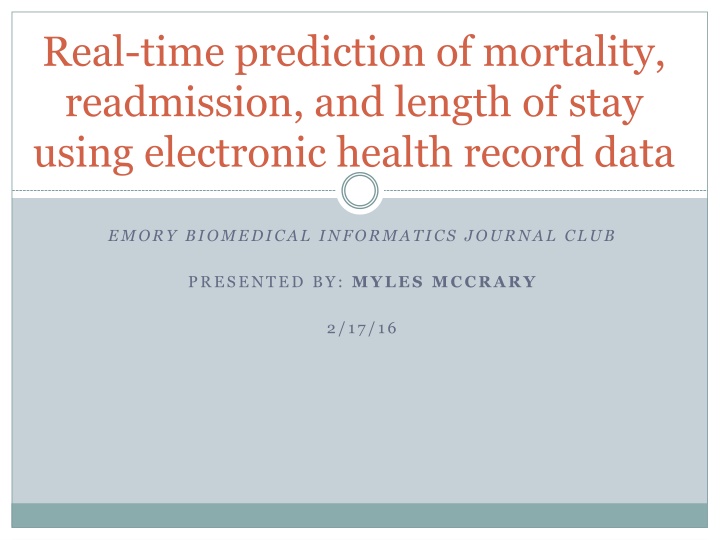
Real-Time Prediction of Mortality, Readmission, and Length of Stay using Electronic Health Record Data
Explore a study on real-time prediction of mortality, readmission, and length of stay for hospitalized patients using electronic health records. The research focuses on updating predictions with new patient information, providing a more detailed patient status forecast than traditional models.
Download Presentation

Please find below an Image/Link to download the presentation.
The content on the website is provided AS IS for your information and personal use only. It may not be sold, licensed, or shared on other websites without obtaining consent from the author. If you encounter any issues during the download, it is possible that the publisher has removed the file from their server.
You are allowed to download the files provided on this website for personal or commercial use, subject to the condition that they are used lawfully. All files are the property of their respective owners.
The content on the website is provided AS IS for your information and personal use only. It may not be sold, licensed, or shared on other websites without obtaining consent from the author.
E N D
Presentation Transcript
Real-time prediction of mortality, readmission, and length of stay using electronic health record data EMORY BIOMEDICAL INFORMATICS JOURNAL CLUB PRESENTED BY: MYLES MCCRARY 2/17/16
Introduction and Background About me Approach to choosing paper Significance and background of the paper Previous models Few studies update predictions as new information about patient comes in Many use history of health care utilization as proxies for clinical status Few studies look at length of stay across all conditions Most models predict only a single outcome within a given time period
Objectives of Dr. Cais Model Predictive model for real-time predictions of length of stay, mortality, and readmission for hospitalized patients using electronic health records (EHRs) Simultaneous estimation of sequence of future daily probabilities which are updated as more information comes in Provide a finer-grained longitudinal forecast of patient status
Study Methodology Data Electronic health records (EHRs) from 32634 patients admitted to a Sydney metropolitan hospital via the ED over a 2.5 year time period Data linkage between hospital EHRs and New South Wales data sets Each patient: 1 year history, 6 month postadmission records, ED visits, deaths 32634 patients total 24625 patients for training set 8009 patients for test set 1 year 1.5 years Time
Study Methodology Variables Static: demographics, patient history, administrative info Dynamic: days already in hospital, ward type, lab/path reports Wards correlated to major diagnostic categories (readily available in real time as opposed to codes) Patient comorbidities estimated using codes from patients previous hospital admission only 31% Only cancer patients and patients with mental health conditions included Patient outcomes Probability of being in hospital, discharged ( at home ) or dead during each of the 7 days following an update
Model Generation (Figure 2) Feature selection algorithm Correlation-based feature selection approach and a best-first search algorithm Feature subsets searched by a greedy hill-climbing algorithm augmented with a backtracking facility Product: selected features most highly correlated with the output classes, but not correlated with each other
Model Generation (Figure 2) Representation of features with probability of an outcome Nodes: 7 target days, selected primary features, selected secondary features Arcs: created from target days to selected primary features, and from primary features to secondary features
How well does the model work? Temporal validation to evaluate ability of model to predict events for unseen patients Weekly Avg 0.76 0.71 0.73 0.64 0.84 0.77 0.66 0.82 0.84 0.93 0.23 0.82 0.82 0.8 0.55 0.8 Day 1 Day 2 Day 3 Day 4 Day 5 Day 6 Day 7 AUC ACC PPV NPV AUC ACC PPV NPV AUC ACC PPV NPV AUC ACC PPV NPV 0.78 0.78 0.85 0.5 0.84 0.81 0.54 0.87 0.87 0.97 0.14 0.99 0.83 0.86 0.51 0.79 0.77 0.74 0.78 0.62 0.84 0.78 0.65 0.82 0.86 0.96 0.24 0.97 0.82 0.83 0.56 0.8 0.76 0.71 0.73 0.65 0.84 0.77 0.67 0.81 0.84 0.93 0.28 0.95 0.82 0.8 0.56 0.8 0.76 0.7 0.72 0.66 0.84 0.77 0.68 0.81 0.84 0.92 0.29 0.94 0.82 0.8 0.56 0.81 0.76 0.69 0.7 0.67 0.85 0.76 0.69 0.81 0.84 0.92 0.31 0.94 0.81 0.79 0.57 0.8 0.75 0.68 0.69 0.68 0.84 0.76 0.69 0.8 0.83 0.91 0.32 0.93 0.81 0.78 0.57 0.8 0.74 0.67 0.66 0.68 0.84 0.75 0.69 0.8 0.83 0.9 0.33 0.93 0.8 0.77 0.56 0.8 Hospital Home Death Daily Avg
Sequences of Future Daily Probabilities Patient outcome trajectories Groups: Death Discharged alive Continuing hospitalization Readmitted after discharge
Critiques Tradeoffs Non-disease specific Study design Definition and inclusion of patient comorbidities Math error (s?) in data table Results Ability to predict hospitalization was low (< 0.8) No discussion of anomalous or unpredicted outcomes Example: predicted to be discharged, but died Example: predicted to die, but discharged
Discussion and Conclusion This study presents a non-disease specific, validated model for estimating the probability of future patient outcomes after a new lab/path report is available Consolidates remaining days of hospitalization, death, readmission in same outcome variable Predicts a sequence of future daily probabilities rather than a single probability over a given time period Has potential to be a useful tool in the clinic Study design (i.e. inclusion criteria) and low level of predictability (hospital prediction) may be limiting factors






















